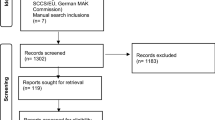Abstract
Objectives
Many hairdressers experience work-related symptoms from the airways caused by bleaching powder. This contains persulphates, which could be irritating to the mucous membrane and also may evoke an allergic reaction. However, specific IgE antibodies are difficult to detect. We found earlier that hairdressers with work-related bleaching powder-associated nasal symptoms reacted to persulphate, but that atopics also did and that the mechanism appeared to be similar in the two groups. In this study, we analysed gene expression of cytokines in the nose in order to further investigate the mechanism for work-related bleaching powder-associated nasal symptoms.
Methods
The study subjects belonged to either hairdressers with work-related bleaching powder-associated nasal symptoms (S; n = 6), hairdressers without work-related bleaching powder-associated symptoms (WS; n = 7) or atopics (A; n = 6). Nasal lavage was performed before and during (up to 4 h after the last challenge) provocation with potassium persulphate. Expression of two genes involved in allergic inflammation [interleukin 5 (IL5) and IL13] and one involved in cell-mediated immunity (interferon-gamma; IFNG) were analysed in nasal lavage with quantitative PCR.
Results
The change of IL5 in the S group differed when compared to the WS group (P = 0.0051), in the A group when compared to the WS group (P = 0.014), but not in the S group when compared to the A group (P = 0.82). The change of IL13 in the A group differed when compared to the S (P = 0.041) and WS (P = 0.014) groups, but no difference was noticed between the S and WS groups (P = 0.30). The relative level of IFNG increased from before challenge to during challenge in the S group (P = 0.031).
Conclusions
Symptomatic hairdressers showed increased expression of IL5 and IFNG, but not IL13, during challenge. Hairdressers without work-related bleaching powder-associated nasal symptoms showed no markedly changed reaction. Atopics showed increased expression of IL5 and IL13. Thus, this may indicate a difference in the mechanism of symptoms between symptomatic hairdressers and atopics. However, due to the low number of participants, further studies are needed to elucidate the mechanism for persulphate-associated nasal symptoms.


Similar content being viewed by others
References
Aalto-Korte K, Mäkinen-Kiljunen S (2003) Specific immunoglobulin E in patients with immediate persulfate hypersensitivity. Contact Dermatitis 49:22–25. doi:10.1111/j.0105-1873.2003.00134.x
Albin M, Rylander L, Mikoczy Z, Lillienberg L, Dahlman Höglund A, Brisman J et al (2002) Incidence of asthma in female Swedish hairdressers. Occup Environ Med 59:119–123. doi:10.1136/oem.59.2.119
Brisman J, Albin M, Rylander L, Mikoczy Z, Lillienberg L, Dahlman Höglund A et al (2003) The incidence of respiratory symptoms in female Swedish hairdressers. Am J Ind Med 44:673–678. doi:10.1002/ajim.10293
Hytönen M, Leino T, Sala E, Kanerva L, Tupasela O, Malmberg H (1997) Nasal provocation test in the diagnostics of hairdressers’ occupational rhinitis. Acta Otolaryngol Suppl 529:133–136. doi:10.3109/00016489709124104
Johnson VJ, Yucesoy B, Reynolds JS, Fluharty K, Wang W, Richardson D et al (2007) Inhalation of toluene diisocyanate vapor induces allergic rhinitis in mice. J Immunol 179:1864–1871
Jones MG, Floyd A, Nouri-Aria KT, Jacobson MR, Durham SR, Taylor AN et al (2006) Is occupational asthma to diisocyanates a non-IgE-mediated disease? J Allergy Clin Immunol 117:663–669. doi:10.1016/j.jaci.2005.09.053
Kronholm Diab K, Truedsson L, Albin M, Nielsen J (2009) Persulphate challenge in female hairdressers with nasal hyperreactivity suggests immune cell, but no IgE reaction. Int Arch Occup Environ Health. doi:10.1007/s00420-008-0392-3
Leino T, Tammilehto L, Luukkonen R, Nordman H (1997) Self reported respiratory symptoms and diseases among hairdressers. Occup Environ Med 54:452–455. doi:10.1136/oem.54.6.452
Leino T, Tammilehto L, Hytönen M, Sala E, Paakkulainen H, Kanerva L (1998) Occupational skin and respiratory diseases among hairdressers. Scand J Work Environ Health 24:398–406
Malm L, Wihl JÅ, Lamm CJ, Lindqvist N (1981) Reduction of metacholine-induced nasal secretion by treatment with a new topical steroid in perennial non-allergic rhinitis. Allergy 36:209–214. doi:10.1111/j.1398-9995.1981.tb01836.x
Moscato G, Galdi E (2006) Asthma and hairdressers. Curr Opin Allergy Clin Immunol 6:91–95. doi:10.1097/01.all.0000216850.72452.43
Moscato G, Pignatti P, Yacoub MR, Romano C, Spezia S, Perfetti L (2005) Occupational asthma and occupational rhinitis in hairdressers. Chest 128:3590–3598. doi:10.1378/chest.128.5.3590
Muñoz X, Cruz MJ, Orriols R, Bravo C, Espuga M, Morell F (2003) Occupational asthma due to persulfate salts: diagnosis and follow-up. Chest 123:2124–2129. doi:10.1378/chest.123.6.2124
Pang S, Fiume MZ (2001) Final report on the safety assessment of ammonium, potassium, and sodium persulfate. Int J Toxicol 20(Suppl 3):7–21. doi:10.1080/10915810152630710
Till S, Durham S, Dickason R, Huston D, Bungre J, Walker S et al (1997) IL-13 production by allergen-stimulated T cells is increased in allergic disease and associated with IL-5 but not IFN-gamma expression. Immunology 91:53–57. doi:10.1046/j.1365-2567.1997.00218.x
Acknowledgments
We thank Anna Axmon for her statistical assistance. The study was supported by the Swedish Council for Working Life and Social Research, Skane county council’s research and development foundation, and the Medical Faculty at Lund University, Sweden.
Author information
Authors and Affiliations
Corresponding author
Rights and permissions
About this article
Cite this article
Jönsson, L.S., Broberg, K., Paulsson, K. et al. Gene expression in nasal lavage from hairdressers exposed to persulphate. Int Arch Occup Environ Health 82, 1261–1266 (2009). https://doi.org/10.1007/s00420-009-0415-8
Received:
Accepted:
Published:
Issue Date:
DOI: https://doi.org/10.1007/s00420-009-0415-8




